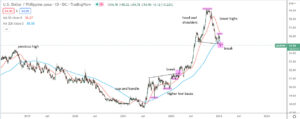The Peso’s Recovery in 2023
The USDPHP exchange rate surged to an all-time high of 59.20 in 2022 from only 50.99 at the start of the year. The said rise was mainly on the back of the aggressive interest rate hikes of the US Federal Reserve and the reluctance of our very own Bangko Sentral ng Pilipinas to be ahead of the curve in dealing with domestic inflation. In 2022, the Fed increased its benchmark interest rate by 425 basis points to a 15-year high of 4.5% as the US’ inflation heated up to a 40-year high of 9.1% in June. Part of the reason of the jump in inflation in the US, and globally for the matter, was the surge in commodity prices, particularly oil and other fuel sources, in the first half of 2022 due to the war between Russia and Ukraine. Supply chain issues due to the said war, covid-related restrictions in China, and improving demand also contributed to the rise in global inflation. In the Philippines, domestic inflation likewise leapt to a 4-year high of 8.1% as of December 2022 due to the increase in fuel and persistent rise in food prices. Despite the jump in local inflation, the BSP only raised its rates by 350 basis points to 5.5%. Its reluctance to match the Fed’s hikes and be ahead of our own inflation issues have, unfortunately, led to the narrowing of the interest rate differential between the US and Philippines from 175 basis points to as low as 75 basis.
The Fed’s hawkishness and the BSP’s relative dovishness have, of course, led investors to flee the peso and other peso-denominated assets. The logic was actually quite simple to understand. To illustrate, the US is a developed and the biggest economy in the world while the Philippines is an emerging market. It is, therefore, a given that investments in the Philippines would generally yield more compared to the US since they are by default ‘riskier’ than that of the US. With the increase in the rates in the US and the BSP’s reluctance to do so, the risk premium of Philippine assets have shrunk to the point that it is no longer logical to take in significantly more risk by holding Philippine assets for a measly 0.75% extra yield. That’s what happened last year which led to the further depreciation of the peso and the decline in other Philippine assets like stocks.
For 2023, though, the Fed is only expected to increase its rates by 100 basis points as the US’ inflation has started to taper. This is in a stark contrast compared to the degree of rate hikes that it did last year. On the other end, the BSP is still poised to keep its monetary policy tight as domestic inflation has not cooled down. In fact, Philippine inflation has gone up in 9 out of 12 months last year to mark a fresh 4-year high at the end of 2022. If the BSP finally commits to its goal of stabilizing prices by monetary means, then it should not really start to loosen or even pause until inflation starts to cool. With the prospect of a less tight Fed policy relative to that of the BSP, then the USDPHP exchange rate may finally turn lower. In other words, the Philippine peso may finally recover and strengthen against the US dollar.
From a technical standpoint, the USDPHP exchange rate appears to have just pivoted off a bearish reversal in the form of a head and shoulders. With its fall below the neckline support of the said top and decline below its key 200-day moving average, the currency pair may soon establish a new bear wave (the peso to enter into a new bull wave). Recall that the USDPHP exchange rate’s ascent to an all-time high of 59.20 was actually triggered by a pivot off a bullish reversal in the form of a cup and handle last March 2022. In any case, the potential appreciation of the Peso in the present year given the fundamental and technical reasons discussed above may also translate to the recovery of other Philippine assets like stocks.
_____
To know more about the Trading Edge Equity Advisor, kindly click HERE. Subscribe now to receive email alerts before the price moves! Here’s what our students and subscribers say. 🙂
*Consensus target price or average target price given by the major foreign and local brokers of various stocks on top of index names are available in our Equity Advisor!












